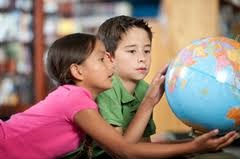In North Carolina, teachers are evaluated on how they encourage students and colleagues to be globally aware. To be a proficient teacher in this area, teachers must “promote global awareness and its relevance to the subjects, (North Carolina Educator Effectiveness System [NCEES], 2015).” To be characterized as an accomplished teacher, integration of global awareness activities must be demonstrated in the lessons taught (NCEES, 2015). While this is a step toward building a globally-minded student, it is a small step. To give students an edge in today’s marketplace, they need to be more than aware – they need to develop global understanding.
Two significant ways to develop global understanding is through perspectives teaching and real-world connections using today’s real-world tools. Perspectives teaching is teaching students to be open-minded to hear and understand another’s point of view. That does not mean that one has to agree with that perspective, but open to listening to it and understanding the culture from which that point of view stems. This is why having students engaged in collaborative groups is essential in the elementary grades – it is the basis for building the understanding that we all have different ideas based on our experiences and culture. Perspectives teaching can be effectively taught through global literature (including children’s books, fairytales and folk lore, quotes, plays, movies and poetry) and role-playing lessons. Teaching students to compare with their own culture helps them not only understand a new culture, but equally helps them further define their own culture.
Teachers too should be encouraged to read global literature written for adults to gain perspective themselves about a certain region in the world so as they teach perspectives, they can be alert to any possible misconceptions or over-generalizations. Here are a few suggested books for children and adults:
- Extra Credit by Andrew Clements compares the point of view of a student in Iowa and a student in Afghanistan using landscapes, cultural differences and similarities.
- The Boy Who Harnessed the Wind by William Kamkwamba shares the struggle of a village in Malawi and how one boy’s inventiveness helped to solve a problem in his community. It can also be linked to the use of electricity and how it is used and valued in different communities.
- It Happened on the Way to War by Rye Barcott takes you to the Kibera slum of Nairobi, Kenya, and shares how one person, connecting with others can make a difference. The videos on his non-profit organization website can be used in class: http://cfk.unc.edu/ while students will be captivated by the story of village children who wanted to play soccer (futbol) but had no ball and how they instead made the ball from plastic bags! Futbol video - http://cfk.unc.edu/2011/03/kiberasoccerballs/
Two great books about how girls/women are treated differently around the world are King Peggy by Peggielene Bartels and Eleanor Herman, and I am Malala by Malala Yousatzai and Christina Lamb.
If teachers help students understand cultures and respect the perspectives that each offers, students will become global citizens who can make significant and globally-minded decisions and differences in the world.
Cathy Dalimonte currently serves as the Assistant Principal at Queens Creek Elementary in Swansboro, North Carolina. She began her teaching career in 1991 and has had an expansive career to include teaching K-5 regular education and STEM classes, and her service as a Curriculum Coordinator and Family Liaison. She recently published Global STEM Navigators in the Science and Children Educational Journal (October 2013).



No comments:
Post a Comment